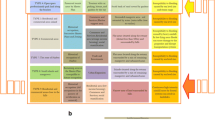Abstract
The world is urbanizing fast and climate change impacts are already being felt in urban agglomerations across the globe. The United Nations Report has projected that India will add 404 million urban inhabitants by 2050 (World Urbanization Prospects 2014). Because of high population densities and increased industrial activities, cities contribute to climate change and also face serious risks due to impacts of climate change. Being engines of growth, cities are a hub of economic centres, thus, economic losses due to climate changes are expected to be significantly high in urban areas making them extremely vulnerable to disasters. In spite of growing evidence of climate change impacts on Indian cities, both the state authorities and the civic bodies are unable to wed urban planning exercise with environmental planning. Current plans and policies are not holistic, and fail to meet the future escalating demands of urban population and possible urban disasters. This paper explores these issues through two case studies of Indian megacities—Bengaluru in Karnataka and Mumbai in Maharashtra. Former focuses on problems faced by urban residential communities located in low-lying areas of the city. Poor urban planning and mindless construction mania has accentuated cases of urban flooding in Bengaluru. The second case study of Mumbai looks at the July 2005 floods when the entire metropolis was marooned due to unprecedented heavy rainfall. It puts in perspective various scientific studies that show impacts of climate change in Mumbai and the associated risks. Both the cases re-emphasise the fact that urban planning is not a top-to-down approach and it cannot be done undertaken in isolation. In wake of growing evidence of climate change impacts in urban areas, it is imperative that a holistic “environmental urban planning” is undertaken to help Indian cities adapt to climate change.
Access this chapter
Tax calculation will be finalised at checkout
Purchases are for personal use only
Similar content being viewed by others
Notes
- 1.
Fernando (2008) paper titled ‘Disappearance and privatisation of lakes in Bengaluru’ mentions that Bengaluru has only 117 lakes. The disappearance of Banglaore lake started from 1980s but has increased due to rapid urbanization process. While there were 262 lakes in 1961, but official statistics mentions presence of only 117 lakes, but only 33 lakes are still more or less visible on satellite imagery. (http://base.d-p-h.info/en/fiches/dph/fiche-dph-7689.html).
- 2.
The city of Bengaluru is getting around 950 MLD of water from Cauvery and Arkavathy sources as against the present demand of 1350MLD for a population of around 9 million. As such, there is a short fall of 400MLD (www.bwssb.org).
- 3.
Walkability Indix measures several factors—easy and safe access to mass transit and other public transport modes, good and continuous footpaths, easily crossable roads, disabled friendly pavements with ramps and absence of obstructions like trees, electricity poles and street hawkers.
- 4.
- 5.
- 6.
Anand Patwardhan 2013, professor, Shailesh J Mehta School of Management, IIT Bombay, September 28, personal communication.
- 7.
- 8.
- 9.
- 10.
- 11.
- 12.
Rajiv Jalota 2013, additional municipal commissioner, MCGM, Oct 3, personal communication.
- 13.
L.S. Vhatkar 2013, director (ES&P), MCGM, October 3, personal communication.
- 14.
- 15.
L.S. Vhatkar 2013, director (ES&P), MCGM, October 3, personal communication.
References
Helen, S. N. H., & Yeo, W. C. (2013). Lee Kuan Yew School of Public Policy National University of Singapore, April 2013.
http://archive.deccanherald.com/deccanherald/oct24/i5.asp, Friday, October 24, 2003.
http://ramuBengaluru.blogspot.in/2013/06/the-first-flooding-of-Bengaluru.html
http://www.pacindia.org/uploads/default/files/publications/pdf/5d2e2897b6e7d46ccf7035d9a7be709d.pdf
Malini, R., https://lsecities.net/media/objects/articles/Bengaluru-high-tech-and-the-monsoon/en-gb/
Manasi, S., Latha, N., & Poornima (2015). Pathways to sanitation: Growing challenges and access to urban poor—A study of Bengaluru City, deliverable 2, ISEC project report submitted to HSMI.
Manasi, S., & Smitha, K. C. (2012). Case study—floods in Bengaluru: No respect for water bodies and water courses. In Ekalavya Prasad, K.J. Joy, Suhas Paranjape, Shruthi Vispute (Eds.), Agony of floods—Flood induced water conflicts in India. Forum for Policy Dialogue on Water Conflicts in India, October.
Ranganathan, M., (2014). ‘Mafias’ in the waterscape: Informality and everyday public authority in Bangalore. Water Alternatives, 7 (1): 89–105
Ramachandra, T. V., Aithal, B., & Uttam Kumar (2012). Conservation of wetlands to mitigate urban floods. Journal of Resources, Energy and Development, 9(1), 1–22.
Ramachandra, T. V., & Mujumdar, P. Urban floods, case study of India.
Ramachandra, T. V., & Uttam Kumar (2009). Land Surface temperature with land cover dynamics: Multi-resolution, spatio-temporal data analysis of Greater Bangalore. International Journal of Geoinformatics, 5(3), 43–53.
Sridhar, K., & Kumar, S. (2012). India’s urban environment: Macro-economic context, challenges and policies.
World Urbanization Prospects (2014). http://www.un.org/en/development/desa/news/population/world-urbanization-prospects-2014.html
Author information
Authors and Affiliations
Corresponding author
Editor information
Editors and Affiliations
Rights and permissions
Copyright information
© 2016 Springer International Publishing Switzerland
About this chapter
Cite this chapter
Manasi, S., Jamwal, N. (2016). Lack of Environmental Planning Exacerbating Climate Change Risks in Urban India: Experiences from Megacities of Bengaluru and Mumbai . In: Nautiyal, S., Schaldach, R., Raju, K., Kaechele, H., Pritchard, B., Rao, K. (eds) Climate Change Challenge (3C) and Social-Economic-Ecological Interface-Building. Environmental Science and Engineering(). Springer, Cham. https://doi.org/10.1007/978-3-319-31014-5_28
Download citation
DOI: https://doi.org/10.1007/978-3-319-31014-5_28
Published:
Publisher Name: Springer, Cham
Print ISBN: 978-3-319-31013-8
Online ISBN: 978-3-319-31014-5
eBook Packages: Earth and Environmental ScienceEarth and Environmental Science (R0)




